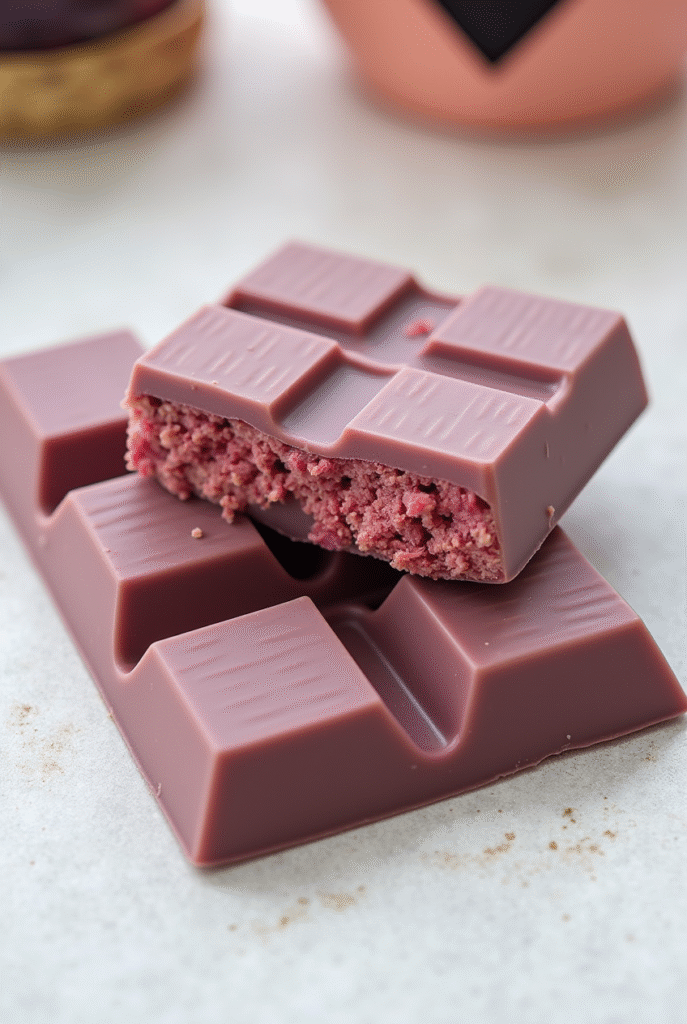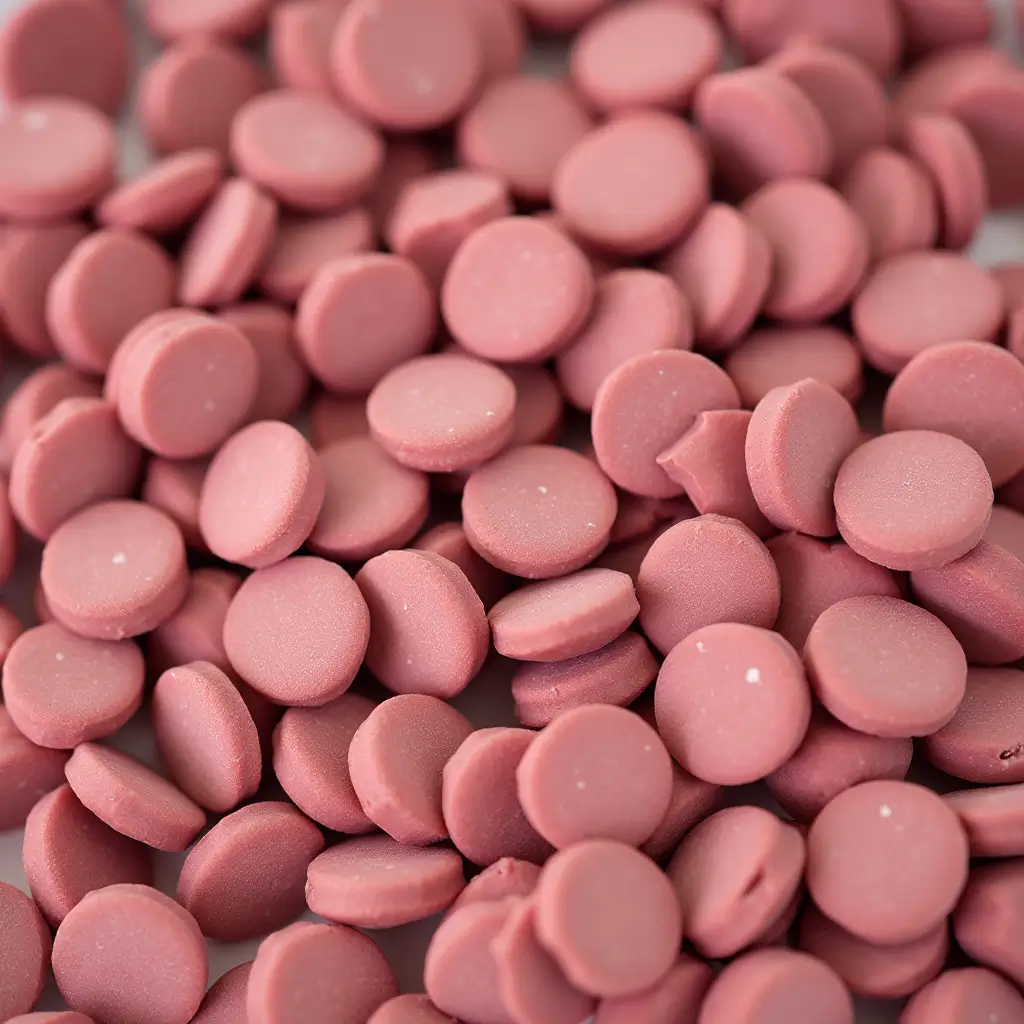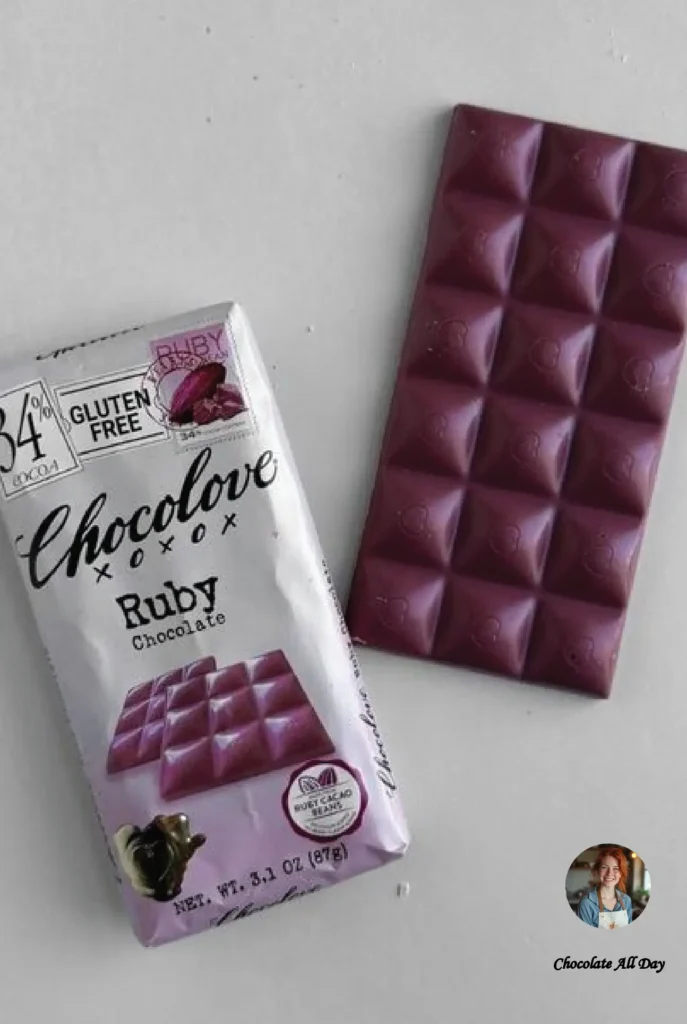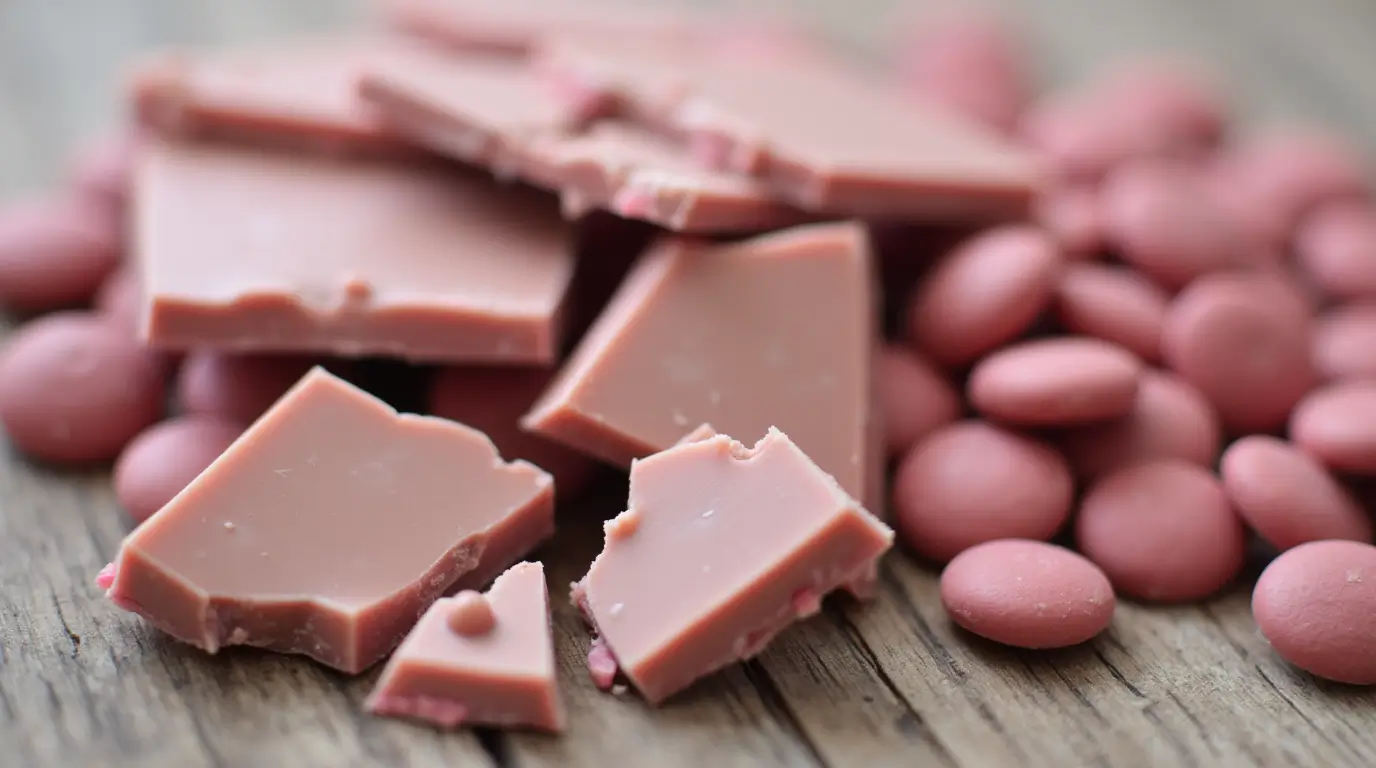What is Ruby Chocolate? Taste, How It’s Made, History & More!
The world of chocolate traditionally consisted of three varieties: dark, milk, and white. But in 2017, a fourth contender entered the scene, captivating chocolate lovers worldwide with its distinctive pink hue and fruity flavor profile. Join me as we explore everything there is to know about ruby chocolate, from its mysterious creation process to where you can find it for your next indulgent treat.
Table of Contents
What is Ruby Chocolate?
Defining the Fourth Chocolate
Ruby chocolate represents the first new chocolate variety introduced to the world in over 80 years. Often called the “fourth chocolate,” it stands apart from dark, milk, and white chocolate both in appearance and taste. What makes it truly unique is that its pink color and berry-like flavor come naturally from the specific cacao beans used and their processing method, rather than added colors or flavors.
The Unique Pink Color and Fruity Flavor
The most striking feature of ruby chocolate is undoubtedly its natural pink color, ranging from a soft rose to a vibrant ruby red depending on the specific formulation. This visual appeal is matched by its distinctive taste profile—tangy, sweet, and reminiscent of berries, particularly raspberries and strawberries, despite containing no fruit ingredients.
Not a New Bean Variety
Contrary to some initial assumptions, ruby chocolate isn’t made from a new species of cacao bean. Instead, it comes from existing varieties of cacao beans (primarily from Ecuador, Brazil, and Ivory Coast) that possess specific properties. These beans naturally contain higher levels of certain compounds that, when processed in a particular way, yield the characteristic ruby color and flavor.
Ruby Cacao vs. Ruby Chocolate
It’s worth noting the distinction between “ruby cacao” (the processed beans) and “ruby chocolate” (the finished product). Ruby cacao refers to the specially selected and processed beans that serve as the base material, while ruby chocolate is the final confection that includes additional ingredients like sugar, milk powder, and cocoa butter.
The History of Ruby Chocolate
Introduction by Barry Callebaut (2017)
Ruby chocolate made its grand debut in September 2017 in Shanghai, China, when Barry Callebaut, one of the world’s largest cocoa processors and chocolate manufacturers, unveiled it to the public. This Swiss-Belgian chocolate company presented ruby chocolate as a revolutionary innovation in the chocolate industry.
A Decade in Development
The pink chocolate didn’t appear overnight. Barry Callebaut spent more than ten years researching and developing ruby chocolate before introducing it to the world. The company’s R&D team discovered that certain cacao beans could yield pink chocolate through specific processing techniques, and they worked meticulously to perfect the formula.
Initial Excitement and Media Attention
When ruby chocolate was first revealed, it generated tremendous buzz in the food industry and media. Food journalists, chocolatiers, and influencers eagerly sampled this new creation, with many praising its innovative character and unique taste experience. Some skeptics wondered if it was just a marketing gimmick, while others hailed it as a genuine innovation.
Release in Different Regions (China, Japan, Europe, North America)
Following its Shanghai debut, ruby chocolate gradually rolled out to different markets. Japan was among the first countries to embrace it commercially, with Nestlé launching Ruby KitKats there in January 2018. Europe followed, and North America had to wait until 2019 due to FDA regulations regarding the classification of chocolate products.
The “Millennial Chocolate” Branding
Barry Callebaut strategically positioned ruby chocolate as the “millennial chocolate,” targeting younger consumers who value unique experiences and Instagram-worthy foods. Its photogenic pink color made it particularly appealing for social media sharing, helping to drive its popularity among this demographic.
Limited Initial Availability and Hype
Ruby chocolate’s limited availability in its early days only heightened consumer curiosity and demand. The controlled release created a sense of exclusivity, with chocolate enthusiasts actively seeking out opportunities to try this new confection, further fueling the hype around the product.
How is Ruby Chocolate Made? The Science Behind the Pink

Barry Callebaut’s Patented Process (Trade Secret)
The exact method for producing ruby chocolate remains a closely guarded trade secret protected by patents held by Barry Callebaut. While the company has revealed some general information about the process, many specific details remain confidential, adding to the mystique surrounding this pink chocolate.
Using Unfermented Cocoa Nibs
One key aspect of ruby chocolate production involves using minimally fermented or unfermented cocoa beans. Traditional chocolate making relies on fully fermented beans, but the ruby variety requires beans that retain certain compounds that would otherwise be lost during extensive fermentation.
Treatment with Acidic Solution
Reports suggest that the ruby chocolate process involves treating the cocoa nibs with an acidic solution. This acid treatment helps preserve and enhance the natural compounds responsible for the pink color and fruity flavor notes, while also affecting the overall taste profile.
Retaining Natural Red Color and Tart Taste
The careful processing method preserves the natural reddish pigments present in specific cacao beans while developing the characteristic tart flavor profile. The challenge lies in maintaining these properties throughout the chocolate-making process, as both the color and flavor compounds are relatively unstable.
Ingredients: Cocoa Butter, Sugar, Milk Powder, Cocoa Mass, Citric Acid
A typical ruby chocolate formula includes cocoa butter, sugar, milk powder, cocoa mass, and citric acid. The citric acid serves both as a flavor enhancer, contributing to the tangy taste, and as a preservative for the pink color. The proportions of these ingredients vary between different manufacturers who license the technology from Barry Callebaut.
Comparison to White Chocolate Production
Ruby chocolate’s production process bears some similarities to white chocolate manufacturing, particularly in terms of ingredient composition. Both contain cocoa butter, sugar, and milk solids, though ruby chocolate typically includes some cocoa mass as well. The major difference lies in the specific beans used and their processing method.
No Artificial Colors or Flavors Added
Barry Callebaut maintains that ruby chocolate contains no artificial colors or flavors. The pink color and berry taste come naturally from the beans and their processing, though the addition of citric acid does enhance these characteristics. This natural claim is part of what makes ruby chocolate intriguing to many consumers.
What Does Ruby Chocolate Taste Like? A Flavor Profile

Sweet and Berry-Like Notes (Strawberry, Raspberry)
The most prominent aspect of ruby chocolate’s flavor is its berry-like character. Most tasters detect notes reminiscent of strawberries, raspberries, or cranberries. This fruitiness is balanced with a creamy sweetness that’s characteristic of milk chocolate.
Smooth Texture
Ruby chocolate offers a smooth, velvety texture similar to high-quality milk chocolate. It melts readily on the tongue, delivering its complex flavor profile in waves, starting with the initial sweetness followed by the fruity notes.
Absence of Added Fruit
What makes ruby chocolate fascinating is that these fruit flavors emerge naturally without the addition of any actual fruit ingredients or flavorings. The taste comes from the specific compounds present in the selected cacao beans and how they’re processed.
Potential for Sour or Acidic Finish (Citric Acid)
Many tasters note a slight acidic or sour finish to ruby chocolate, which adds complexity to its flavor profile. This tanginess comes partly from the natural properties of the cacao beans and partly from the citric acid used in processing.
Expert Opinions on the Taste
Chocolate experts have offered varied assessments of ruby chocolate. Some, like renowned chocolatier Jacques Torres, have praised its innovative character and unique flavor profile. Others, like chocolate writer Dom Ramsey, have suggested it’s essentially a form of flavored white chocolate, albeit one created through a novel process.
Personal Taste Variations
As with any food, personal preference plays a significant role in how people experience ruby chocolate. Some find its berry notes refreshing and delightful, while others may consider it too sweet or acidic. The novelty factor also influences perceptions, with first-time tasters often responding more to its uniqueness than returning customers.
Ruby Chocolate vs. Other Chocolate Types
Comparison to Milk, Dark, and White Chocolate
While dark chocolate is defined by its high cocoa solids content and robust, sometimes bitter flavor, and milk chocolate offers a creamier, sweeter profile with added milk solids, ruby chocolate carves out its own niche with its fruity character. White chocolate, which contains no cocoa solids (only cocoa butter), perhaps bears the closest resemblance to ruby in terms of composition, though their flavor profiles diverge significantly.
Cocoa Solids and Cocoa Butter Content
Ruby chocolate typically contains a lower percentage of cocoa solids than dark chocolate but more than white chocolate (which has none). Its cocoa butter content is substantial, contributing to its smooth mouthfeel and helping to carry its distinct flavor.
Creaminess and Bitterness Levels
In terms of creaminess, ruby chocolate sits somewhere between milk and white chocolate. It lacks the bitterness characteristic of dark chocolate, instead offering a tangy edge that provides complexity without astringency.
Ruby Chocolate as a Flavored White Chocolate (Expert Perspective)
Some chocolate experts consider ruby chocolate to be essentially a specialized form of white chocolate with a unique processing method that yields its distinctive color and flavor. This perspective comes from the similar ingredient profiles and the prominent role of cocoa butter in both varieties.
Cooking and Baking with Ruby Chocolate
Considerations for Heat and Moisture
Working with ruby chocolate requires special care, particularly regarding temperature. Like all chocolate, it needs proper tempering for a professional finish, but ruby chocolate can be especially sensitive to high heat, which may affect both its color and flavor profile.
Potential for Discoloration (Turning Grey)
One challenge when baking with ruby chocolate is its tendency to lose its pink color when exposed to excessive heat or moisture. The compounds responsible for the ruby hue are relatively unstable and can degrade under harsh conditions, resulting in a grayish appearance.
Tips to Retain the Red Color (Adding Acid)
To help preserve ruby chocolate’s signature color when cooking, some chefs recommend adding a small amount of additional acid, such as lemon juice or cream of tartar. This extra acidity helps stabilize the pink pigments during heating.
Best Uses: Fruit-Flavored Sweets, Ice Cream, Frosting
Ruby chocolate pairs exceptionally well with fruits that complement its natural berry notes, such as strawberries, raspberries, and lychees. It also works beautifully in applications that don’t require extensive heating, like ice cream, mousses, and frostings, where its color and flavor remain intact.
Ruby Chocolate Powder for Drinks
Ruby chocolate is also available in powder form, ideal for creating vibrant pink hot chocolates, milkshakes, and other beverages. The powder offers a convenient way to incorporate ruby chocolate’s distinctive flavor and color into drinks without the complexities of melting and tempering.
Is Ruby Chocolate Healthy? Nutritional Information
Contains Antioxidants, Minerals (Magnesium, Iron)
Like other chocolates, ruby chocolate contains some beneficial compounds, including antioxidants and minerals such as magnesium and iron, though in relatively modest amounts. These come from the cocoa components in the chocolate.
Lower Sugar Content Compared to Milk and Dark Chocolate (Claimed)
Some producers claim that ruby chocolate contains less sugar than conventional milk chocolate, though this varies by brand and formulation. As with any chocolate product, it’s important to check the specific nutritional information of the particular ruby chocolate you’re consuming.
Presence of Protein, Calcium, Riboflavin, Vitamin B12
The milk solids in ruby chocolate contribute small amounts of protein, calcium, and B vitamins, including riboflavin and B12. However, these nutrients are present in relatively small quantities compared to more nutrient-dense foods.
Not Necessarily a “Healthy” Food
Despite containing some beneficial compounds, ruby chocolate should be considered an indulgence rather than a health food. Like all chocolates, it’s relatively high in sugar and fat, making it best enjoyed in moderation as part of a balanced diet.
Pairing with Fruits and Yogurt
For a slightly more nutritious treat, ruby chocolate pairs wonderfully with fresh fruits like strawberries, raspberries, and pomegranate seeds. It also complements Greek yogurt nicely, with its tanginess echoing ruby chocolate’s own acidic notes.
Where to Buy Ruby Chocolate

Availability in Retail Shops and Online
Ruby chocolate has become increasingly available in specialty chocolate shops, gourmet food stores, and online retailers. Its availability continues to expand as more consumers become curious about this relatively new chocolate variety.
Major Retailers (Walmart, Kroger, Amazon)
In the United States, ruby chocolate products can now be found at major retailers like Walmart and Kroger, as well as online marketplaces such as Amazon (here is the link to the product). The selection varies by location, with urban areas typically offering more options.
Direct Purchase from Barry Callebaut
Professional chefs and serious home bakers can purchase ruby couverture (high-quality chocolate for cooking) directly from Barry Callebaut or through specialty baking supply stores that carry their products.
Ruby Chocolate Products (Bars, Chips, Powder, KitKats)
Ruby chocolate comes in various forms, including bars for direct consumption, chips for baking, powder for drinks, and as an ingredient in confections like KitKat bars. The KitKat Ruby became one of the most accessible and popular ways for consumers to try this new chocolate type.
International Availability
Availability varies significantly by country. Japan, South Korea, and parts of Europe embraced ruby chocolate early on, while regulatory considerations delayed its introduction in markets like the United States. Today, it’s available in most major chocolate-consuming countries, though product selection differs by region.
Cost Considerations
Ruby chocolate typically commands a premium price compared to conventional chocolate varieties. This higher cost reflects both its novelty and the specialized production process. As production scales up and more manufacturers license the technology, prices may eventually moderate.
The Future of Ruby Chocolate: Will It Last?
Initial Hype vs. Current Popularity
While ruby chocolate’s introduction generated tremendous buzz, the question remains whether it will establish itself as a permanent fixture in the chocolate landscape or fade as a passing trend. Current indicators suggest it has found a niche audience, though not quite achieving the ubiquity of traditional chocolate varieties.
A “Hedonistic Indulgence” for Millennials
Ruby chocolate continues to appeal strongly to younger consumers who value novel food experiences and visually striking treats. Its positioning as a “millennial chocolate” seems to have resonated with its target demographic, particularly for special occasions and gifting.
Adaptability and Unique Properties
Ruby chocolate’s distinctive color and flavor profile give it certain advantages in the confectionery market. Its visual appeal makes it particularly valuable for special occasions like Valentine’s Day and for creating visually striking desserts and confections.
Expert Predictions
Industry experts remain divided on ruby chocolate’s long-term prospects. Some see it becoming a permanent niche product alongside traditional varieties, while others predict it will eventually be superseded by new innovations. What seems clear is that ruby chocolate has already influenced the industry, encouraging exploration of novel processing techniques and flavor profiles.
Ruby Chocolate FAQs
Is Ruby Chocolate Real Chocolate?
Yes, ruby chocolate is considered real chocolate by most standards, containing cocoa butter and some cocoa solids. However, regulatory definitions vary by country, which affected its initial classification in markets like the U.S. where it first appeared as “ruby couverture” rather than “chocolate” due to FDA definitions.
Can You Make Ruby Chocolate at Home?
No, true ruby chocolate cannot be made at home as it requires specific cacao beans and a proprietary processing method patented by Barry Callebaut. Home cooks can create pink-colored chocolate using white chocolate and natural colorings, but this would not replicate the natural fruity flavor of genuine ruby chocolate.
Is Ruby Chocolate Vegan?
Standard ruby chocolate is not vegan as it contains milk powder. However, as the product category expands, some manufacturers are exploring dairy-free alternatives that might provide vegan options in the future.
What Makes Ruby Chocolate Pink? Is It Natural?
Ruby chocolate’s pink color comes naturally from the specific cacao beans used and the way they’re processed. According to Barry Callebaut, the color develops without adding artificial colorings, though the exact process remains proprietary.
What is Ruby Couverture?
Ruby couverture refers to high-quality ruby chocolate with a higher percentage of cocoa butter, designed specifically for professional baking and confectionery applications. The higher cocoa butter content gives it excellent melting properties ideal for coating and molding.
Can You Use Ruby Chocolate for Baking?
Yes, ruby chocolate can be used for baking, though with some limitations. It works best in applications where it won’t be exposed to excessive heat, which can affect its color and flavor. It’s particularly good for decorations, frostings, ganaches, and mousse.
Ruby chocolate represents one of the most interesting innovations in the chocolate world in recent decades. Whether it’s here to stay or simply a fascinating chapter in chocolate’s ongoing evolution, it has certainly brought new excitement and possibilities to chocolate lovers everywhere. Have you tried ruby chocolate yet? Share your experience in the comments below!
You can find more related articles in the Chocolate pairings Section

